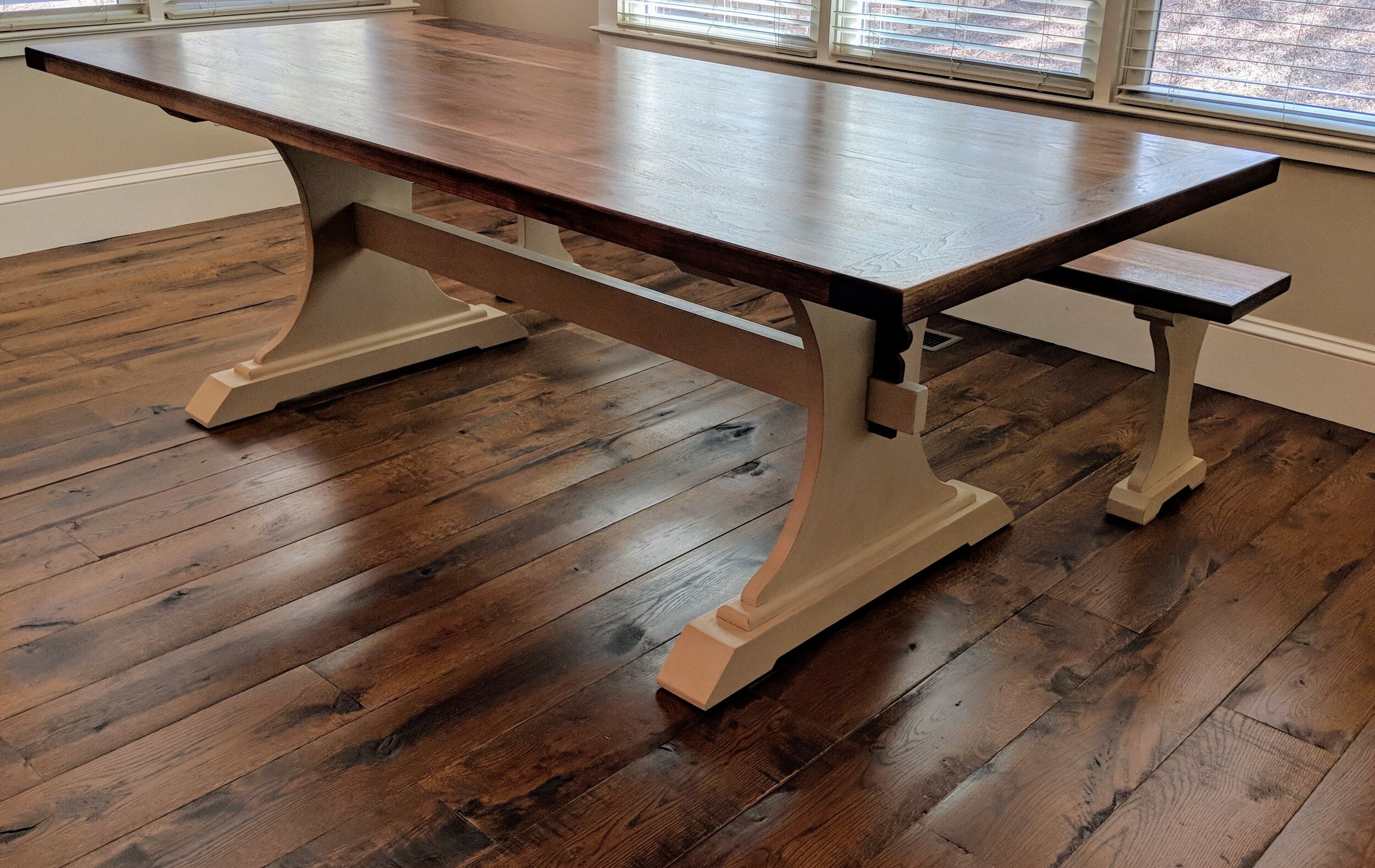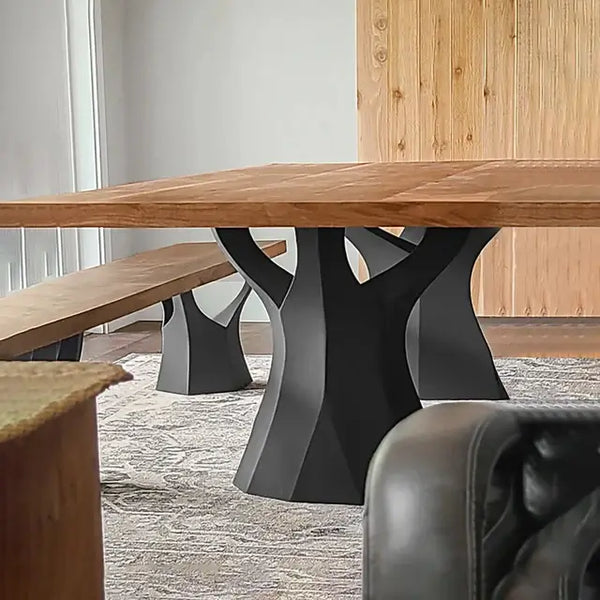The Impact of Dining Room Table Legs on Your Table's Overall Design
The Impact of Dining Room Table Legs on Your Table's Overall Design
Blog Article
From Standard to Modern: Locate the Perfect Dining-room Table Legs for Your Style
The choice of dining-room table legs plays a pivotal function in specifying the total character of your space, linking the space in between traditional craftsmanship and modern-day visual appeals. While classic designs such as cabriole and turned legs evoke a feeling of ageless sophistication, contemporary styles like hairpin and geometric alternatives present a possibility for striking visual rate of interest. Assessing the right balance between these styles needs a nuanced understanding of your existing decoration and personal taste. As you take into consideration these elements, the question continues to be: just how can you seamlessly incorporate these diverse leg styles to develop an unified eating experience?
Understanding Table Leg Styles
The range of dining space table leg designs can significantly influence both the looks and capability of the space. Each leg design adds one-of-a-kind aesthetic components and practical features, satisfying diverse style choices and usage demands. Comprehending these designs is vital for choosing the right eating table that aligns with your total interior decoration vision.
For example, tapered legs offer a tidy, timeless look that can boost a space's style, while pedestal bases supply stability and optimize legroom, making them suitable for smaller sized areas. Hairpin legs, a characteristic of mid-century contemporary style, introduce a commercial style, allowing for an airy, open feeling. Trestle legs stimulate rustic charm, providing robust support and a sense of eternity.
Wood legs can bring warmth and structure, whereas steel options commonly convey a sleek, contemporary vibe. Inevitably, recognizing table leg designs is essential for producing a natural eating location that reflects personal design while making certain functionality and convenience.
Standard Table Leg Options
When choosing dining-room table legs, typical options usually personify ageless elegance and craftsmanship. These styles mirror a rich heritage and a commitment to top quality, making them perfect for those that value traditional visual appeals.
One of the most legendary conventional leg designs is the cabriole leg, identified by its graceful curved shape. This style usually includes attractive carvings and is most frequently located in Queen Anne and Chippendale furniture. One more prominent alternative is the transformed leg, which flaunts a collection of smooth, rounded shapes that give a timeless appearance while preserving stability.
Additionally, the straight leg, while easy, supplies a tough and unadorned structure that can mix perfectly with a variety of tabletop designs. For those drawn to ornate describing, claw-and-ball feet legs evoke a sense of splendour and can act as a sensational focal factor in any type of dining space.
Lastly, pedestal bases, although not strictly legs, offer an alternate traditional option that permits ample legroom and can be perfectly carved. Each of these standard leg designs contributes to the total atmosphere of a dining space, weding function with aesthetic charm.

Modern Table Leg Layouts
Modern table leg layouts provide a varied series of styles that highlight tidy lines and innovative materials. These designs commonly focus on capability while functioning as striking prime focus within a dining space. Minimalist visual appeals prevail, with legs crafted from products such as metal, glass, and crafted timber, which contribute to a airy and modern feel.
One prominent style is the hairpin leg, characterized by its slender, conical framework that provides stability without frustrating the table top (dining room table legs). This design is usually located in mid-century modern furniture and can easily enhance numerous table forms. One more fad is making use of geometric forms, where legs may handle angular or unbalanced forms, including aesthetic interest and a touch of artistry

Mixing Styles for One-of-a-kind Rooms
Typically, property owners look for to create unique dining spaces that mirror their individual style by blending numerous design components. This technique allows for the unification of diverse appearances, leading to an unified yet distinctive atmosphere. Pairing a rustic wooden table with sleek, contemporary steel legs can develop an eye-catching contrast that raises the area's overall charm.
In addition, integrating vintage see this table legs with contemporary table tops can evoke a sense of background while keeping a modern-day sensibility. Such combinations not just display specific taste but likewise motivate imagination, allowing homeowners to curate a room that feels both personal and inviting.
Color plays a critical duty in this mixing procedure; choosing table legs that enhance or contrast with the existing color design can improve aesthetic rate of interest. As an example, whitewashed legs can soften the daring of a dark table surface, creating a well balanced aesthetic.
Tips for Selecting the Right Legs
Selecting the right table legs is essential for attaining both capability and visual allure in your eating space. Begin by taking into consideration the overall style of your area. Typical settings gain from legs visit this site right here that include intricate carvings or transformed styles, while modern rooms might require smooth, minimalist designs.
Following, assess the height and stability of the legs. dining room table legs. Common table vary in between 28 to 30 inches in height, so guarantee the legs match this dimension for comfort. Furthermore, durable products, such as wood or steel, can boost stability and longevity
Review the leg form too-- choices consist of straight, tapered, or pedestal designs. Straight legs offer a classic appearance, while tapered legs can add a touch of beauty. Pedestal bases offer adequate legroom and are excellent for smaller sized spaces.
Conclusion
In summary, selecting the perfect dining room table legs calls for careful factor to consider of both modern-day and typical designs. Typical alternatives such as cabriole and transformed legs provide timeless elegance, while modern layouts like barrette and geometric forms offer a contemporary touch. By integrating leg design, height, and material with the overall décor, a cohesive and welcoming environment can be achieved. Eventually, the selected table legs ought to reflect the wanted aesthetic, boosting the eating experience within the room.
The variety of eating room table leg designs can dramatically affect both the looks and performance of the room. Eventually, recognizing table leg styles is essential for producing a cohesive dining location that reflects individual style while making certain functionality and convenience.One of the most iconic standard leg styles is the cabriole leg, characterized by its elegant bent shape. Straight legs offer a timeless look, while tapered legs can include a touch of elegance.In recap, picking the optimal dining area table legs requires careful factor to consider of both traditional and contemporary styles.
Report this page